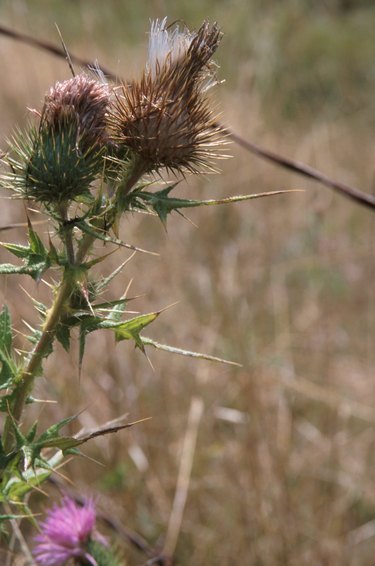
Plants known as thistles don't all belong to the same species, but their similar appearance and the qualities they have in common -- toughness, prickliness and invasiveness -- make them universally despised. To devise a homemade strategy for eradicating thistles, you need to understand how the weeds grow. Many thistle species grow by both seed and underground rhizomes. To kill the current generation of thistles, you'll need to progressively weaken the underground parts of the plant by repeatedly attacking the above-ground portions. To prevent windblown seeds from sprouting, make the soil as thistle-hostile as possible.
General Strategy
Video of the Day
Each time the stem, leaves and flowers of the thistle are killed or removed, the root system grows weaker. The roots' gradual death is due to its now-absent, above-ground parts' failure to collect sunlight for fuel. Eventually, the root system dies. Because this process happens only after repeated removal of the above-ground parts, you'll need to repeatedly kill the stems, flowers and leaves. If new thistles emerge from wind-blown seed, continue this plan of attack, until there are fewer and fewer thistles in the area each year.
Video of the Day
Basic Formula
Vinegar is a commonly-recommended solution for weeds, especially for tough ones such as thistles. For best results, don't use food-grade, 5 percent vinegar. Instead, look for 20 percent vinegar, often sold as a household cleaner or weed killer. Because of its high acidity, be sure to wear protective gloves and goggles, and avoid splashing onto your skin as your pour because it burns. Clear the area of people and pets. Because you'll need the formulation to be as strong as possible, don't dilute the vinegar. Instead, apply it directly onto problem areas.
Method
It's helpful to pull or chop down as many thistles as you can prior treatment; doing so means fewer seeds will be spread. If the thistles you're targeting grow near plants you are trying to cultivate, a spray bottle is the best way to concentrate the vinegar on only soil directly around the thistles. Otherwise, pour the vinegar directly over the entire thistle patch. For best results, pour the vinegar when the sun is at its brightest, and when no rain is expected. Repeat the spraying or soaking at least one additional time or until new growth stops appearing. Because vinegar lowers the pH of the soil, adding wood ash or limestone to the ground about four weeks after soaking large areas will help ensure the ability to grow other plants.
Following Up
Once you've killed the current crop of thistles, take steps to ensure fewer of the noxious weeds in the future. The presence of thistles on your property indicates soil deficiencies. If you correct these problems, the ground will be less hospitable to thistles -- and friendlier to cultivated plants that prefer fertile, aerated soil. Thistles thrive in compacted soil, so working a 2- to 4- inch layer of homemade compost into the top 8 to 12 inches of the problem area may help mitigate the thistle problem. Because thistles usually grow where magnesium is low, adding a simple source of the nutrient may help. Epsom salts are a household item you may already have that is rich in magnesium. Sprinkle about 0.5 pounds Epsom salts over a 100 square foot area. Thistles may also indicate low calcium. Save your eggshells to provide calcium to the soil. Work about 2.5 pounds cleaned, dried and crushed eggshells into a 100 square foot area, preferably as you're adding compost.
- University of Missouri Extension: Thistles and Thistle-like Plants
- Mother Earth News: Weed Control Strategy
- Gardens Alive: Thistle Eradication
- Pittsburgh Post Gazette: Carefully Apply Vinegar to Eliminate Thistles
- Cornell University Weed Management: Canada Thistle
- National Sustainable Agriculture Information Service: Thistle Control Alternatives
- NW Farms and Food: What Weeds Can Tell Us About the Soil